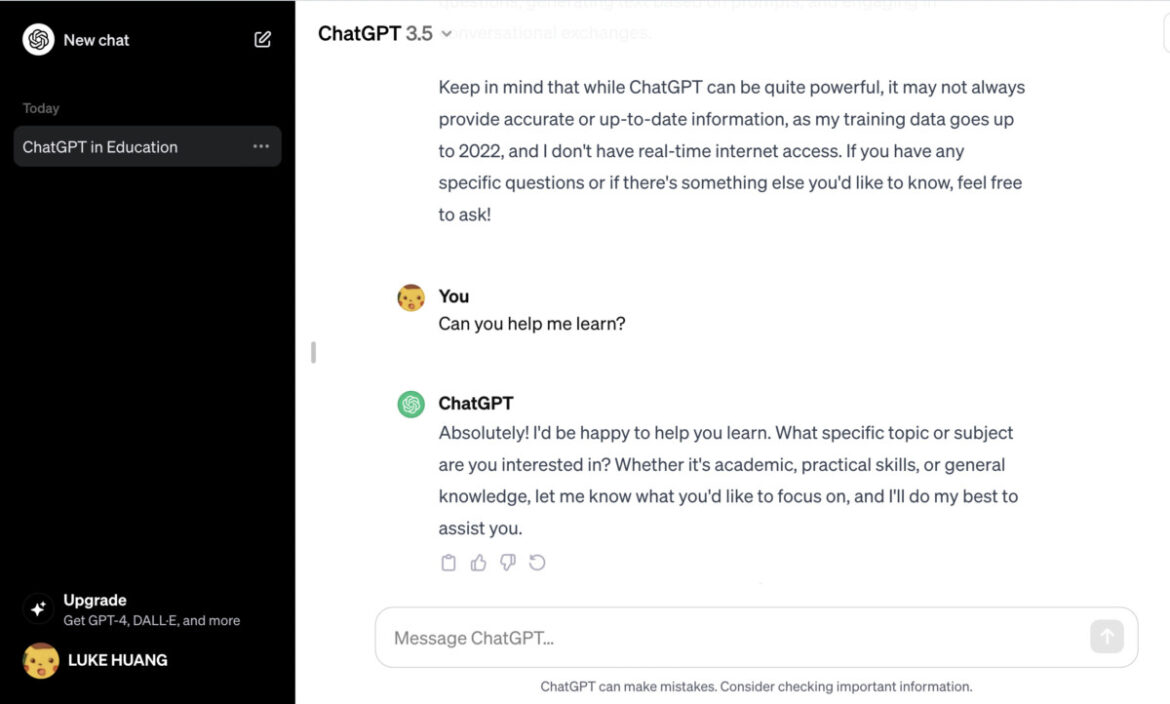Luke Huang, Features Editor
@lukehcourant
Two decades ago, Google transformed the way we access information, turning the vast expanse of the internet into a searchable trove at our fingertips. Doomsayers said it would be the end of traditional research with books, while optimists prophesied that it would usher in a new age of democratized information and education. Yet, the truth turned out to be somewhere in the middle.
Today, we find ourselves at a similar crossroads with the integration of Artificial Intelligence into education. Artificial Intelligence, in its essence, refers to machines programmed to mimic cognitive functions such as learning and problem-solving — capabilities traditionally thought to require human intelligence. Its applications in education are vast, ranging from data analysis and administrative automation to personalized learning experiences. AI’s promise in education lies in its ability to adapt — to curate and customize learning — to individual student needs, pace, and preferences.
With AI’s potential in education, Superintendent of New Canaan Public Schools Dr. Bryan Luizzi approaches it optimistically and pragmatically. “We’re at a place where you could call it ‘FAFO’ which is fool around and find out,” he said. “We are encouraging people to try some things creatively with it. But doing it in a way that is safe.”
The Evolution of Educational Tools
In fact, we are already using artificial intelligence in our education. Tools like Google Translate, Grammarly, or Khan Academy’s progressive learning have existed for more than a decade. But generative AI, a frontier in machine learning technology, has taken AI’s promise a step further. Unlike its predecessors focused on processing and interpreting data, generative AI can create new, original content. This leap from reactive to proactive AI presents an array of possibilities and challenges in educational contexts.
However, the rapid development and pace of change in AI technology have left many feeling overwhelmed. Earlier this year, some industry insiders, including Elon Musk, Steve Wozniak, and over 1,000 other experts, advocated for a six-month pause on the development of AI technology more powerful than OpenAI’s GPT-4, citing “profound risks to society and humanity” due to the uncontrolled race in AI development.
In this context of exploration mixed with caution, Dr. Bryan Luizzi believes in an experimental spirit with AI, starting from the familiar ground. “Finding ways to use it in our day-to-day lives teaches us a lot about it so that then we can, by extension, figure out ways to use it both professionally in our work, and also ultimately with our students in our classrooms,” he said. “I actually encourage people to start out by using ChatGPT for something like how to cook the perfect ribeye steak or chicken parmesan.”
Most students discovered artificial intelligence tools outside the context of academic assistance. “ChatGPT was something I discovered later when I saw my brother using it to try and make jokes,” Freshman Alison Stiles said. “He was, like, trying to generate any amount of jokes on ChatGPT but kept failing.”
Personalized Learning with AI
According to Science Department Chair and Teacher Michael LeDuc, artificial intelligence has already become a useful tool in education. “Across the district, we have teachers using technology to personalize the learning experience for students,” he said. “This could mean adapting reading assignments to different lexile levels for students, shortening readings to essential content, or generating the starting point for activities based on given topics.”
Senior Adrian McMahon found benefits in its helping him study. “When I am very lost on how to approach studying for a particular test or quiz, I tell Chat GPT about what it is I am reviewing and then the AI gives me a condensed ‘study plan’ to use,” he said.
This personalization is not limited to the sciences. Alison uses AI tools to supplement traditional study methods, where an interactive and responsive way of studying not only aids in reinforcing her learning but also introduces an element of customization in her educational journey. “I often use ChatGPT to generate questions for topics I’m learning in math,” Alison said. “For example, if I’m trying to factor polynomials, I might ask it to give me some polynomials to factor.”
The ability of AI to provide tailored practice on demand illustrates a shift from one-size-fits-all educational resources to a more personalized learning experience. Adrian found similar benefits in his study routine. “If I want a more in-depth look into a difficult topic, I can easily learn about that, but at the same time, if I prefer a simpler overview of a topic I can just as quickly be given that,” Adrian said. “Not only that, but AI can help a lot when it comes to brainstorming for group projects, making it a great source for initial planning on group presentations of any sort.”
Learning From Past Lessons
As schools navigate the growing presence of technology in education, Math Teacher Jennifer Lee sees a historical parallel in the adoption of phones in classrooms, recalling how it transformed teaching methods. “It gave people the ability to put out quick polls and say, ‘grab your phones,’ and then they would just send out a question,” she said.
While this development marked the beginning of integrating mobile technology into classroom instruction, this transition wasn’t without its challenges. While some saw them as useful tools, others were concerned about their potential to distract or facilitate cheating. “I think the way it really impacted the whole school though, is that it increased the ability to cheat,” Ms. Lee said. “Teachers didn’t even realize that students could just walk by and take a photo of a test as they’re going past another desk.”
This challenge, according to Lee, pushed educators to adapt creatively. “Now I’ve resorted to making multiple versions of every assessment or, on the positive side, it has driven teachers to make more creative assessments,” she said.
Lee also reflects on the advent of YouTube in educational settings. This technology enabled teachers to experiment with flipped classrooms, a model where students engage with lecture content at home and work on practical applications in class. “Especially in a curriculum that was so crowded, it was really nice to be able to take what was kind of the more dry, boring stuff and put it at home and then be able to work on things together during class,” Ms. Lee said.
Navigating AI’s Challenges
However, Adrian is prudent about his reliance on AI. “I have occasionally found that some of the information the AI provides ends up actually being incorrect,” he said.
Adrian’s concerns resonate with those of English Department Chair and Teacher Evan Remley. “Right now, I don’t think anyone is using it on a consistent basis in the English department,” Mr. Remley said. “It’s all-new, and it requires an account, which isn’t set up for under the NCPS privacy agreement.”
These experiences highlight another significant aspect of AI in education — data privacy. “Most students like me really don’t understand the lengths to which the companies behind AI track our data,” Mr. Remley said.
Mr. LeDuc also addresses the challenges, particularly when it comes to content quality and aligning AI tools with existing curricula. “Before using it in the classroom, teachers need to ensure that the content provided by AI tools is accurate, up-to-date, and pedagogically sound,” he said. “For the time being, our textbooks and other vetted resources are more trustworthy and more likely to be at an appropriate level for our students.”
Despite the challenges, Dr. Luizzi remains hopeful about the role of AI in enhancing education.”We have a saying that we don’t want to be on the bleeding edge, but we’d like to be on the cutting edge,” Dr. Luizzi said. “And I think that that’s exactly where we’re positioned. As we look at AI and what we’re doing, for instance, we’re being careful about what we’re doing with students in the classroom, because again, with the data privacy and all of the issues that are there right now we need to be careful.”
Dr. Luizzi acknowledges the inevitability of AI’s influence on students and the impracticality of outright bans. “We know that our students are using it, we’d be crazy to think that they weren’t,” he said. “So I do think a big part of our responsibility today is to really focus on helping them learn to use it responsibly.”
In the face of these developments, Dr. Luizzi concludes the district’s mission is clear, to achieve a balance. “How do we use it responsibly? And how can we teach our students and others even though we can’t do it as a class assignment, if we know that they’re using it, we need to be talking and thinking about how to do so responsibly,” he said.
Adrian’s experiences as a student using AI tools for studying and writing hint at the potential for AI to transform homework and study habits. “AI can be very easily customizable allowing it to fit my exact learning preferences in terms of structure and design,” he said. “But if we aren’t careful, we can easily fall into the trap of regurgitating misinformation.”
Adrian’s and LeDuc’s concerns are not isolated. Mr. Remley also shares his apprehension about AI’s current role in the English department. “Teachers have dabbled with it, tried some things. But it’s been a pretty wild learning curve,” Mr. Remley said. He highlights a key concern about AI replacing the traditional teacher-student dynamic. “Our hesitancy with AI when it replaces that dialogue between teacher and student, ” he said.
The Future of AI and Education
Ultimately, Dr. Luizzi recognizes the transformative potential of AI, yet remains grounded in the importance of responsible use. “It’s important for me to understand the whole scope of all of it, not just one narrow lane of how are we using it in schools,” Dr. Luizzi said. “We need to really get our arms around, what does that mean, when we’re asking students to produce something?”
This vision includes a collaborative effort to deepen the understanding of AI’s capabilities and implications. “We even have a team of people who are coming together and meeting periodically and learning together,” Dr. Luizzi said.
The district has also enlisted a consultant to offer expertise and insights, highlighting the importance of a multi-disciplinary approach to AI education. “I’ve been to lots of webinars, both educational focus, but also business focused,” Dr. Luizzi said, underlining the value of cross-sector learning.
Dr. Luizzi’s holistic perspective on AI reflects a desire to understand its application across various industries. “It’s important for me to understand the whole scope of all of it, not just one narrow lane of how are we using it in schools,” he said. “How are companies using it? How is Microsoft using it? What does it look like through Amazon?”
The perspectives from within the New Canaan district paint a picture of careful experimentation. While AI’s integration into education is in its infancy, the cautious steps being taken today could lay the groundwork for a future where technology serves as a bridge rather than a barrier to learning.
The district’s journey with AI echoes the broader evolution of educational tools. “It’s an exciting time to be in education,” Dr. Luizzi said. “AI is radically changing the world around us, and I am excited to see all of the ways it can improve student learning.”
Ultimately, Dr. Luizzi is an advocate for an approach in education that emphasizes the possibilities of the future over the constraints of the present. “As a district, we look up and imagine what’s possible,” he said. “Taking that orientation towards the future is what’s going to best serve our students and all of us, ultimately helping to create a better world.”




